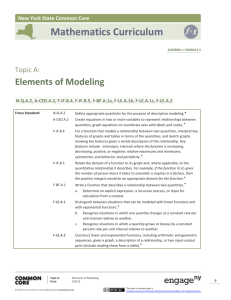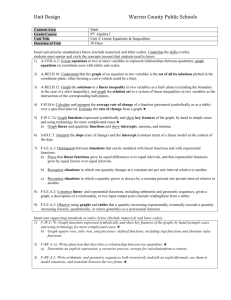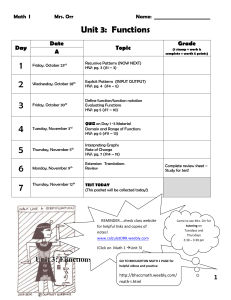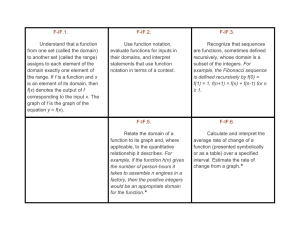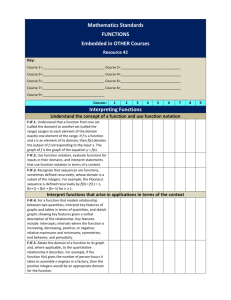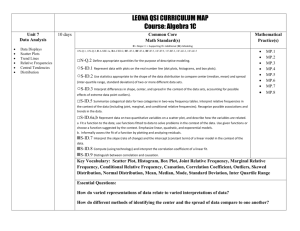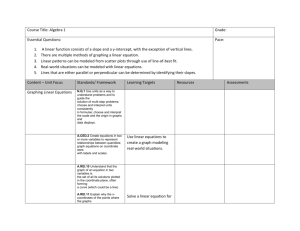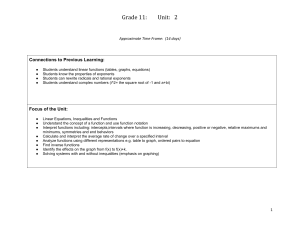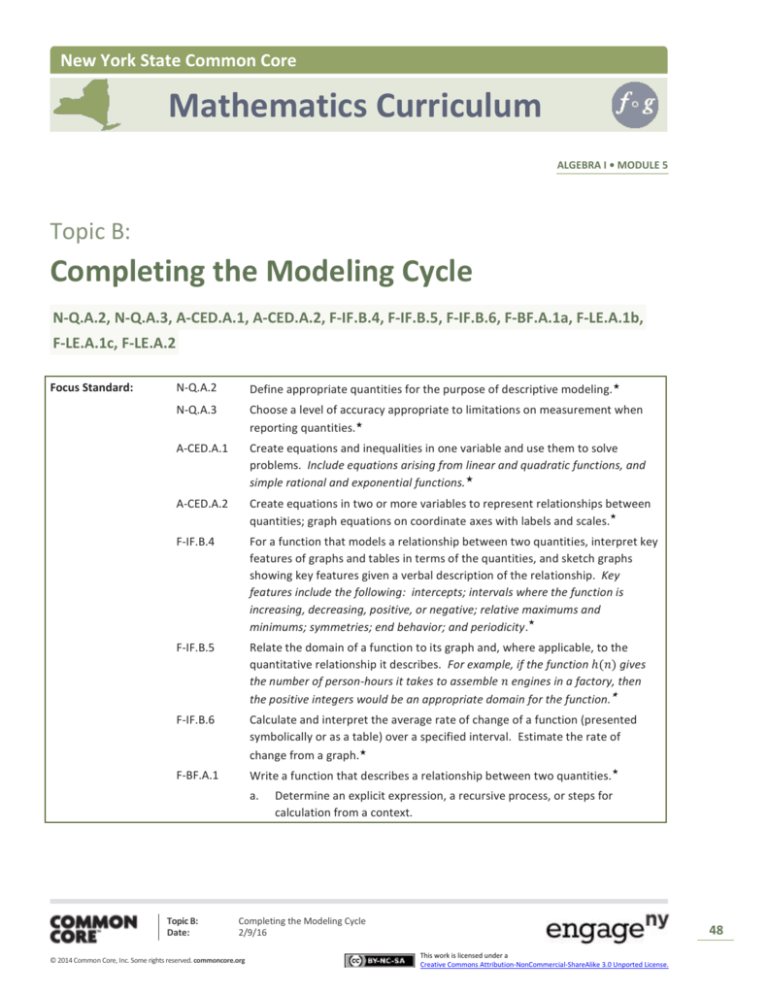
New York State Common Core
Mathematics Curriculum
ALGEBRA I • MODULE 5
Topic B:
Completing the Modeling Cycle
N-Q.A.2, N-Q.A.3, A-CED.A.1, A-CED.A.2, F-IF.B.4, F-IF.B.5, F-IF.B.6, F-BF.A.1a, F-LE.A.1b,
F-LE.A.1c, F-LE.A.2
Focus Standard:
N-Q.A.2
Define appropriate quantities for the purpose of descriptive modeling. ★
N-Q.A.3
Choose a level of accuracy appropriate to limitations on measurement when
reporting quantities.★
A-CED.A.1
Create equations and inequalities in one variable and use them to solve
problems. Include equations arising from linear and quadratic functions, and
simple rational and exponential functions. ★
A-CED.A.2
Create equations in two or more variables to represent relationships between
★
quantities; graph equations on coordinate axes with labels and scales.
F-IF.B.4
For a function that models a relationship between two quantities, interpret key
features of graphs and tables in terms of the quantities, and sketch graphs
showing key features given a verbal description of the relationship. Key
features include the following: intercepts; intervals where the function is
increasing, decreasing, positive, or negative; relative maximums and
★
minimums; symmetries; end behavior; and periodicity.
F-IF.B.5
Relate the domain of a function to its graph and, where applicable, to the
quantitative relationship it describes. For example, if the function ℎ(𝑛) gives
the number of person-hours it takes to assemble 𝑛 engines in a factory, then
★
the positive integers would be an appropriate domain for the function.
F-IF.B.6
Calculate and interpret the average rate of change of a function (presented
symbolically or as a table) over a specified interval. Estimate the rate of
change from a graph.★
F-BF.A.1
Write a function that describes a relationship between two quantities.
a.
Topic B:
Date:
★
Determine an explicit expression, a recursive process, or steps for
calculation from a context.
Completing the Modeling Cycle
2/9/16
© 2014 Common Core, Inc. Some rights reserved. commoncore.org
48
This work is licensed under a
Creative Commons Attribution-NonCommercial-ShareAlike 3.0 Unported License.
Topic B
NYS COMMON CORE MATHEMATICS CURRICULUM
M5
ALGEBRA I
F-LE.A.1
Distinguish between situations that can be modeled with linear functions and
★
with exponential functions.
F-LE.A.2
b.
Recognize situations in which one quantity changes at a constant rate per
unit interval relative to another.
c.
Recognize situations in which a quantity grows or decays by a constant
percent rate per unit interval relative to another.
Construct linear and exponential functions, including arithmetic and geometric
sequences, given a graph, a description of a relationship, or two input-output
pairs (include reading these from a table).★
Instructional Days:
6
Lesson 4:
Modeling a Context from a Graph (E)1
Lesson 5:
Modeling from a Sequence (P)
Lessons 6–7:
Modeling a Context from Data (P, P)
Lessons 8–9:
Modeling a Context from a Verbal Description (P, P)
Topic B follows a similar progression as Topic A, in that students create models for contexts presented as
graphs, data, and verbal descriptions. However, in this topic students complete the entire modeling cycle,
from problem posing and formulation to validation and reporting. In Lesson 4, students use the gamut of
functions covered in the Algebra I course for modeling purposes. They interpret the functions from their
respective graphs: linear, quadratic, exponential, cubic, square root, cube root, absolute value, and other
piecewise functions, including a return to some graphs from Topic A. Students build on their work from those
lessons to complete the modeling cycle. Additionally, students will determine appropriate levels of numerical
accuracy when reporting results.
Building on the work done with sequences in Topic A, in Lesson 5 students learn to recognize when a table of
values represents an arithmetic sequence (linear), a geometric sequence (exponential), or a quadratic sequence.
In this lesson, patterns are presented as a table of values. Sequences that are neither arithmetic (linear) nor
geometric (exponential) may also be explored (e.g., the product of two consecutive numbers: 𝑎𝑛 = 𝑛(𝑛 + 1)).
In Lessons 6 and 7, students develop models from a given data set. They choose the appropriate function
type, interpret key features of the function in context, and make predictions about future results based on
their models. Some data sets will be recognized from Lesson 2 and from Module 2. Some will require a
regression formula and/or a graphing calculator to compare correlation coefficients to find the best fit of the
different function types.
Lessons 8 and 9 are the final lessons of the module and represent the culmination of much of the work
students have done in the course. Here, contexts are presented as verbal descriptions from which students
decide the type(s) of model to use graphs, tables, or equations. They interpret the problems and create a
function, table of values, and/or a graph to model the contextual situation described verbally, including those
involving linear, quadratic, and exponential functions. They use graphs to interpret the function represented
by the equation in terms of its context and to answer questions about the model using the appropriate level
of precision in reporting results. They interpret key features of the function and its graph and use both to
1
Lesson Structure Key: P-Problem Set Lesson, M-Modeling Cycle Lesson, E-Exploration Lesson, S-Socratic Lesson
Topic B:
Date:
Completing the Modeling Cycle
2/9/16
© 2014 Common Core, Inc. Some rights reserved. commoncore.org
49
This work is licensed under a
Creative Commons Attribution-NonCommercial-ShareAlike 3.0 Unported License.
NYS COMMON CORE MATHEMATICS CURRICULUM
Topic B
M5
ALGEBRA I
answer questions related to the context, including calculating and interpreting the rate of change over an
interval. When possible, students should articulate the shortcomings of the models they create; they should
recognize what a model does and does not take into account.
Topic B:
Date:
Completing the Modeling Cycle
2/9/16
© 2014 Common Core, Inc. Some rights reserved. commoncore.org
50
This work is licensed under a
Creative Commons Attribution-NonCommercial-ShareAlike 3.0 Unported License.

